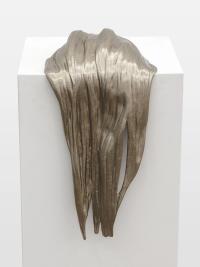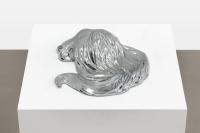Henry CurchodShuriya DavisXin LiuMichelle LopezBerenice OlmedoSigmar Polke
Glad Rags
Works












Installation Views
Press Release
Jan Kaps is thrilled to announce the exhibition Glad Rags featuring works by Henry Curchod, Shuriya Davis, Xin Liu, Michelle Lopez, Berenice Olmedo and Sigmar Polke. A good drawing is like good hair, it goes in many directions, is a bit messy and is held together at the roots. It has a center from which everything grows, maybe something like a head. There is a relationship to space: the fantasy of depth and perspective is based on the reality of geometry and its lines. So this exhibition reflects on the act of drawing and how the sketchiness of lines, shapes and colors serves not only as a springboard for ideas, but often as a means of mapping social and political space. Drawing as such proves to be a useful technique for questioning the authority of the myths, narratives and stories we tell, and even more so the ones we want to believe in. Back to the drawing board: it is the potential of a few lines that can inspire both new designs and the same old revolutions. Because everything that is unfinished, incomplete or not yet realized is perhaps always an abstraction of something that is yet to be. It’s like the outfit you put on before you go out, or the hairstyle after a long night out. In short: Glad Rags are your party clothes. The artist Henry Curchod (b. 1992 in Palo Alto, USA), who uses the tension between painting and drawing to create the energetic pull in his work, also talks about drawing as a tool of criticism. Understanding critique as a platform to insist or reiterate, to question or even interrogate, the qualities of drawing as something inherently provisional, open and suggestive prove to be a useful mechanism. In his slightly anecdotal works, he combines allegory with biting social commentary, creating a unique lens through which to view the absurdity of everyday life. He knows how to be subtle and perceptive in equal measure. By outlining, sketching and sometimes pressing, the artist creates apt satires that rattle the cages of moral conformity. He takes aim at themes such as social hierarchies, masculinity and commercialism, often with an exaggerated but subtly melancholic, surreal visual language. His depictions emphasize the complexity and bizarreness of his subjects. Using humor as a critical tool, Curchod's protagonists find themselves in unexpected situations in which social roles collapse and learned patterns of action and behavior that previously promised security no longer work. By capturing precisely these moments of realization, Curchod encourages reflection on the fragility of social norms and the sometimes shallow depth of human interactions. Shuriya Davis (b. 1996 in Mobile, USA) often works with portraiture, creating introspective paintings that explore themes such as levels of consciousness and subjectivity from the inside out. Their works reveal a deep interest in human psychology and cognitive perception, and the results are as virtuosic as they are contradictory. The artist, who in the past has used images from various cultural fields such as music, television or internet memes, has recently placed anonymous Greek sculptures at the center of their ecstatic compositions, which they excavate and exploit for ideas and formal explorations. Most of their works, which deal with problems of representation, touch on abstraction. Where the figure ends, Shuriya Davis’ abstract paintings begin. Lines unfold into organic, semi-geometric forms, and when viewed from a distance, their canvases merge into powerful fields of color. In negotiating content and form, the artist drew inspiration from different teachings and the question of how to turn the pursuit of mastery inward, as a technique of self-exploration and experimentation. What does mastery look like on a personal, even private level? When it comes to drawing, Shuriya Davis cites Willem de Kooning as a point of reference. While her works are as vibrant as possible, they are not after resolution, but maintain a disorderly harmony, with no real beginning or end. Every mark counts. Michelle Lopez (b. 1970, USA) is best known as a sculptor. From a feminist perspective, her work often undermines the idea of monolithic permanence typically associated with classical sculpture. In particular, she criticizes the Minimalist fantasy of wholeness, the utopian desire for a complete, self-sufficient—shall we say autonomous object. The pinnacle of 20th century egoic delusion. Lopez’s sculptures, on the other hand, are charmingly oblique, flaunting instability and are sometimes full of dents. Interestingly, the artist often gives her works a shiny or otherwise delicious surface finish. As if to underscore her intention to embellish that which is not machine-perfect and resembles the messiness of life with all its traces and complications. This is the case with her GHOST series, a group of mirrored sculptures modeled after her own hair and other Asian stylized tresses. The works deal with the complex politics of identity: visibility, fetishization and disembodiment — both literally and figuratively, these works address the memory of loss and exclusion. Ropes, lines and locks are constant motifs in Lopez’s oeuvre, and in this sense her sculptures are like fragmented drawings that always leave a way out, the possibility for more— or less. Xin Liu (b. 1991 in Xinjiang, China) imagines a future in which civilization has literally risen to new heights by building a world in low Earth orbit. In her video, she explores the history of dropping and recovering rocket debris, which she stages as a thrilling chase through remote landscapes. The protagonist embarks on a journey through valleys, villages and deserts in southwest China in search of the remains of the missiles that have crashed since the 1990s. The focus of the film is the search for these abandoned artifacts themselves. The crashed rocket becomes a symbol, a white stone that marks the earthly end of an extraterrestrial object and serves as a metaphor for social or economic change. Through their narrative, Xin Liu encourages a change of perspective and invites us to reconsider the life cycle of technology and its impact on Earth. The artist intertwines the awe of space exploration with the grounded reality of its aftermath, inviting reflection on the evolving relationship between humanity and its creations. Over the years, Berenice Olmedo (b. 1987 in Oaxaca, Mexico) has become known for both her kinetic and static series of sculptures often using orthoses and prostheses as starting points, emphasizing the potential or limitation of movement. Her sculptures are not simply fragments of bodies, they assemble themselves into their own existence and form themselves into new beings. In a delicate balance, the artist brings movement into play, only to return it to the stillness of the body, to the hollow wholeness of all that it means to be a kind of creature: Not necessarily a person or even a human being, but actually a living, moving thing. Her most recent series, presented in Glad Rags, continues her exploration of walking beings rising from the ground and exploring the transformational potential of both organic matter and its technological counterparts. The artist engages with standardized expectations of our bodies and examines the extent to which external aids are essential to human existence. By reusing forms and materials from the medical field, she questions the pursuit of efficiency and seamless perfection in favor of a more corporeal, political and existential contemporary experience. At the heart of Sigmar Polke’s (b. 1941 in Oels, Silesia; d. 2010 in Cologne, Germany) practice is a tireless exploration of the nature of perception, reality and representation. The artist often uses unconventional materials and techniques, such as the layering of translucent materials or the use of chemical reactions, to achieve unpredictable effects in his works. This playful yet profound questioning of visual language and cultural symbolism imbues his art with a sense of wit, irony and critical engagement, inviting us to critically question our own preconceptions and grapple with the complexities of contemporary existence. His art is characterized by a dynamic interplay between abstraction and figuration, chaos and order, spontaneity and control. His compositions are often teeming with juxtaposed images, ranging from everyday objects to historical references, from pop culture icons to political symbols. Through this multi-layered visual vocabulary, Sigmar Polke’s work challenges us to decipher multiple levels of meaning and invites a dialog that transcends traditional esthetic boundaries.






















